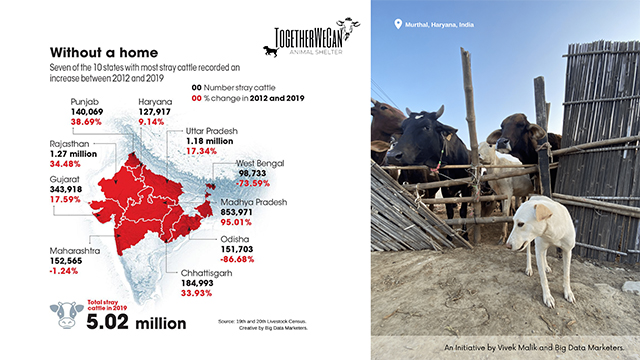Helping Street Animals: Together We Can, an animal shelter initiative by Big Data Marketers
Published on May 12, 2022

Cows, buffaloes, and dogs roaming the streets and eating from garbage bins are a common sight in almost every part of India. Even though there have been multiple government interventions, the problem persists. India has over 5 million stray cattle according to the livestock census data released in January 2020 and more than 35 million stray dogs.
The stray cow attacks on humans and crops in both urban and rural areas are an issue for the residents. Stray cattle are a nuisance to traffic in urban areas and frequently cause road accidents. The abandonment of cattle is unfortunate as they are quite an important resource, contributing to nutritional security and strengthening local livelihood.
Founder and mind behind the animal shelter, Vivek Malik, an Indian Entrepreneur, states there are several reasons for the high share of stray cattle in the country: from neglect of the indigenous populations to excessive focus on crossbreeding in the past few decades. Increased mechanization and the national ban on cow slaughter have further added to the problem.
In the common parlance, stray cattle include cows, bulls, or calves that are abandoned because they are unproductive. They also include low-yield cows, mostly owned by city-dwellers, that are set free to roam about in the open during the daytime. While stray cattle are a traffic nuisance in cities, they also raid crops in villages.
Vivek Malik highlights, Dogs are the most emotionally fulfilling animal and yet we care so little for them. Talking further about stray dogs, Millions live on the streets. Most are direct descendants of their feral canine ancestors, a “breed” much older than any AKC (American Kennel Club) breed. With the recent increase in popularity among Indians of full breed dogs, more and more street dogs have abandoned pets or have bred with pet breeds.
Although they are widely feared because some carry rabies, for the most part, India’s street dogs are not aggressive and will only bite if provoked. Indeed, many are fearful of humans and sadly, the dogs’ fears are well-founded. India’s street dog population is closely associated with municipal sanitation practices – or neglect thereof. Because these homeless dogs often survive by scavenging rubbish, exposed garbage means more healthy dogs – and more puppies. Ironically, this makes the dogs a boon to public sanitation. By scavenging garbage, they reduce perishable waste that could otherwise be a source of contamination for people. And their presence around garbage keeps away other potentially dangerous scavengers, such as rats and mice.
Unfortunately, fear and ignorance have led many Indian citizens and officials to see street dogs as nothing but a nuisance and to seek eradication using inhumane methods such as poisoning and beating. But for every dog killed, another typically comes in to take over that dog’s territory. The only scientific method to humanely reduce street dog populations is mass spay and neuters, commonly known as animal birth control (ABC).
While the Government struggles to protect our street animals like cows and dogs, Vivek Malik is looking forward to sheltering both cows and dogs together with his initiative, Together We Can, starting with the first physical shelter at Murthal, Haryana, India, and aiming to reach all the states by the year 2025.
Follow them on Instagram for all the latest updates @togetherwecan.co.in





















